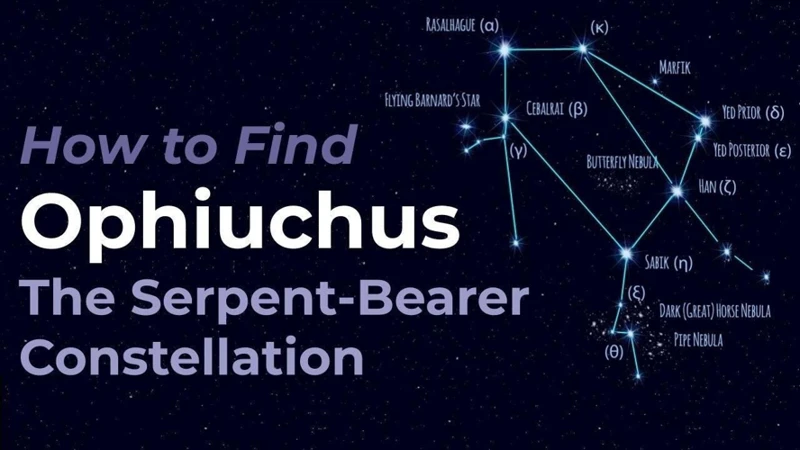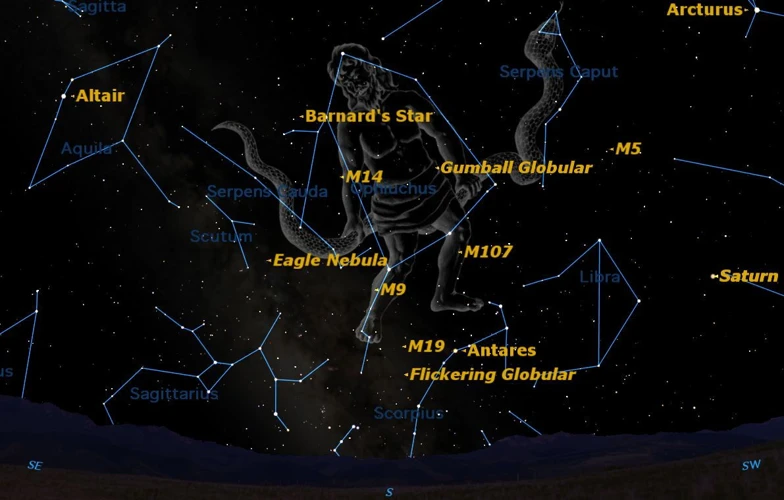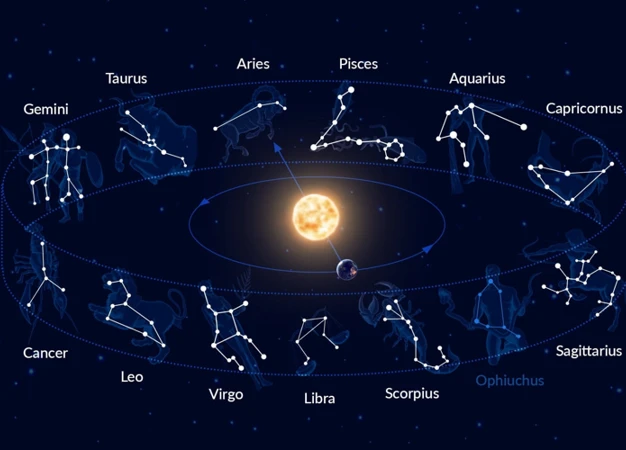The night sky has always captivated and inspired human beings throughout history. One of the most intriguing aspects of the celestial landscape is the presence of constellations, which are made up of groups of stars that form recognizable patterns. These constellations have been given names and assigned symbols, evolving over time to reflect different cultures, myths, and scientific discoveries. In this article, we will explore the fascinating journey of constellation names and symbols, from ancient origins to modern interpretations. Join us on this cosmic journey as we unravel the mysteries of the celestial realm.
Constellation Names

Constellation names have a rich history that spans across ancient and modern civilizations. Ancient Origins take us back to civilizations like ancient Mesopotamia and Egypt, where early astronomers identified and named constellations based on their cultural and religious beliefs. These names often had deep mythological connections, such as Orion, named after a legendary hunter in Greek mythology. Moving on to the Modern Adaptations, constellations have been given new names and identities. In recent centuries, astronomers have added constellations based on scientific discoveries and explorations. One famous addition is the southern constellation “Tucana,” which represents a toucan bird and was named by the Dutch navigators during the Age of Exploration. To explore more about ancient civilizations’ contributions to constellations, check out our article on ancient civilizations’ constellations.
Ancient Origins
The of constellation names can be traced back to civilizations across the globe. In ancient Mesopotamia, astronomers named constellations based on their religious and cultural beliefs. For example, the constellation Taurus represented the sacred bull, often associated with fertility and the goddess Inanna. The Egyptians also contributed to the ancient origins of constellation names, with their emphasis on mythology and astrology. They associated specific constellations with their gods and goddesses, such as the constellation Sirius, which represented the goddess Isis. Ancient China had its own unique constellation system, where stars were grouped into constellations representing animals, such as the constellation Draco, or the dragon. Greek mythology also played a significant role in the naming of constellations. Orion, for instance, was named after the mighty hunter of Greek mythology. These ancient origins have shaped our understanding of constellations today. To learn more about the influence of ancient civilizations on the zodiac constellations, check out our article. For a guide to explore the southern constellations, visit our detailed guide.
Modern Adaptations
1. Scientific Additions: In the modern era, astronomers have made significant contributions to the constellation names. As new galaxies, stars, and celestial bodies were discovered, astronomers felt the need to incorporate these findings into the constellation system. For example, in the mid-18th century, French astronomer Nicolas-Louis de Lacaille introduced 14 new southern constellations to fill the gaps in the night sky unseen by ancient astronomers. These additions included constellations like “Microscopium” and “Telescopium,” reflecting the advancements in telescopic technology.
2. Cultural Influence: Modern adaptations of constellations also include cultural influences, as different societies recognize and interpret star patterns according to their own traditions and beliefs. The Australian Aboriginal people, for instance, identify constellations based on their Dreamtime stories, incorporating elements of their spirituality and their deep connection to the land. In other parts of the world, there are constellations tied to local folklore and legends, such as the constellation “Fu Xi” in Chinese mythology.
3. Contemporary Discoveries: With the advancements in technology and space exploration, new constellations are still being discovered today. These discoveries often come with new names and symbols. One such example is the constellation “Hercules-Corona Borealis Great Wall,” which is considered to be the largest structure in the universe, consisting of a vast chain of galaxies. It was discovered in 2013 and named after the mythical hero and the Northern Crown constellation.
4. Popular Culture References: In modern times, constellations have also been influenced by popular culture. From fictional universes like the Star Wars galaxy to characters from books and movies, some constellations have been unofficially associated with these references by enthusiasts and fans. While these associations are not recognized by official astronomical organizations, they showcase the enduring impact and fascination that constellations hold in popular culture.
The modern adaptations of constellation names reflect the dynamic nature of human understanding and exploration of the cosmos. From scientific progress to cultural influences and contemporary discoveries, constellations continue to evolve and capture the imagination of stargazers and astronomers alike.
Constellation Symbols

Constellation symbols play a crucial role in visually representing the patterns formed by the stars. Early Representations of constellations can be traced back to ancient civilizations, where the symbols were often inspired by the shapes and characteristics of the associated constellations. For example, the constellation Ursa Major, or the Great Bear, was represented by a symbol resembling a bear. These early representations served as a means of identification and navigation in the night sky. As legends and stories became intertwined with constellations, Mythological Influences began shaping the symbols as well. Greek mythology, in particular, played an influential role in assigning symbols to constellations. Hercules, for example, was depicted as a kneeling figure in the constellation Hercules. In more recent times, Contemporary Interpretations of constellation symbols have become more abstract and simplified, often resembling geometric shapes or patterns. The evolution of these symbols has added depth and character to the constellations, offering us glimpses into the cultural and historical significance they hold.
Early Representations
During ancient times, the early representations of constellations varied across different cultures and civilizations. Here are a few notable examples:
1. Egyptian Constellations: In ancient Egypt, constellations held religious and mythological significance. The Egyptians associated various constellations with their gods and goddesses, incorporating them into their belief systems. For instance, the constellation Ursa Major was thought to represent the goddess Isis.
2. Chinese Constellations: Chinese astronomers developed their own system of star maps and constellations. The earliest known Chinese star maps date back to the Han dynasty, and these constellations played a crucial role in agriculture, calendar systems, and celestial observations. One well-known Chinese constellation is the “Azure Dragon” (Qing Long), which symbolized power and protection.
3. Greek Constellations: Greek mythology greatly influenced the early representations of constellations. The Greeks assigned mythological figures and creatures to specific constellations. For example, the constellation Perseus was associated with the heroic son of Zeus, known for slaying the Gorgon Medusa.
4. Babylonian Constellations: The ancient Babylonians were renowned astronomers, contributing significantly to the development of astronomy. They divided the sky into different constellations and associated them with deities and significant celestial events. Notably, the “MUL.APIN” tablet, dating back to the 7th century BCE, contained a collection of Babylonian constellations.
Although early representations of constellations differed across cultures, they all shared a common fascination with mapping and understanding the celestial realm. It is intriguing to trace the origins of these constellations and witness how they have evolved over time.
Mythological Influences
Mythological influences have played a significant role in shaping the symbols associated with constellations. These early representations were often rooted in the myths and legends of ancient cultures. For example, the constellation Ursa Major, also known as the Great Bear, is associated with the myth of Callisto from Greek mythology. According to the story, Zeus transformed Callisto into a bear to protect her from his jealous wife, Hera. Another prominent example is the constellation Orion, which is connected to various myths across different cultures. In Greek mythology, Orion was a hunter who was eventually placed among the stars after his death. Similarly, in Egyptian mythology, the constellation represented Osiris, the god of the afterlife. These mythological influences not only gave meaning and symbolism to the constellations but also provided narratives that brought the night sky to life. To learn more about the mythological origins of constellations, explore our comprehensive guide to zodiac constellations.
Contemporary Interpretations
Contemporary interpretations of constellation symbols have seen a shift towards scientific and astronomical perspectives. In , the focus is on understanding the celestial objects and their relationships with Earth rather than solely relying on mythological stories. Astronomical organizations and societies play a crucial role in establishing standard constellation symbols that are widely used in modern astronomy. For example, the International Astronomical Union (IAU) has defined and formalized the 88 modern constellations, each with its specific symbol. These symbols are often simplified representations of the celestial objects they represent, such as a simplified shape for a constellation named after an animal. To help stargazers easily identify and locate constellations, various stargazing apps and websites have been developed. These digital resources display constellation symbols and provide real-time information about their positions in the night sky, making it accessible for anyone interested in stargazing. Additionally, modern interpretations aim to include constellations from different cultures and regions worldwide. This recognition promotes diversity and allows individuals from various backgrounds to connect with the night sky in their own cultural context. So, whether you are exploring the zodiac constellations or curious about the southern constellations, the contemporary interpretations offer a fascinating blend of scientific knowledge and cultural inclusivity. For a comprehensive guide on southern constellations, make sure to check out our southern constellations guide.
Changing Perceptions
Throughout history, the perception and understanding of constellations have undergone significant transformations. In earlier times, constellations were often seen as divine or mythical figures, with stories woven around them to explain their existence in the night sky. Ancient cultures believed that the stars formed divine patterns, reflecting the actions and characteristics of gods and goddesses. These celestial arrangements were considered markers of celestial events and were used for navigation, agriculture, and religious ceremonies.
However, in the modern era, with advancements in science and technology, the perception of constellations has shifted towards a more scientific and astronomical lens. The rise of telescopes and space explorations has allowed scientists to study the stars more closely, unraveling the true nature of these celestial bodies.
As our understanding of the universe has deepened, constellations have come to be seen as arbitrary groupings of stars, defined by their location and proximity to one another from our perspective on Earth. The International Astronomical Union (IAU) now defines 88 official constellations, with clear boundaries and defined names. These boundaries help astronomers communicate and locate celestial objects more precisely.
As technology has advanced, our methods of observing and recording constellations have also evolved. Digital sky mapping software and planetariums now allow us to explore the night sky in great detail, enhancing our understanding of the constellations’ true nature.
The shift in perception has not diminished the beauty and wonder associated with constellations. Rather, it has provided a deeper appreciation for their intricate patterns and the vastness of the universe. Whether we view them as divine figures or scientific groupings, constellations continue to inspire and spark the imagination of stargazers and astronomers alike.
The changing perceptions of constellations reflect the evolving nature of human knowledge and understanding. From ancient mythological associations to modern scientific interpretations, constellations have remained a constant source of fascination and intrigue, reminding us of our place in the vast cosmos.
Conclusion
In , the evolution of constellation names and symbols reflects the dynamic nature of human perception and understanding of the cosmos. From the ancient civilizations that sought to make sense of the stars through their mythologies and religious beliefs to the modern scientific advancements that have expanded our knowledge, constellations have undergone a fascinating transformation. The names and symbols of constellations encompass a wide range of cultural, historical, and scientific influences, making them a unique blend of art, mythology, and astronomy. These celestial patterns continue to captivate and inspire us, connecting us to the vastness of the universe and reminding us of our place within it. Whether we gaze up at the night sky with a scientific lens or simply appreciate the beauty and wonder it holds, the constellations are a testament to the enduring human fascination with the stars above.
Frequently Asked Questions
1. How were the ancient constellations named?
Ancient constellations were named based on cultural, religious, and mythological beliefs prevalent in the civilizations of that time. These names often reflected important figures, animals, or objects in their myths and stories.
2. Are all constellation names still in use today?
No, not all ancient constellation names are still in use today. Over time, some names have been replaced or modified as new constellations were discovered or scientific knowledge advanced. However, many ancient names do remain in use alongside newer additions.
3. How were modern constellations named?
Modern constellations were named based on various factors, including scientific discoveries, explorations, and historical figures. Astronomers used these events and personalities as inspiration to assign names to newly recognized or created constellations.
4. Are constellation names the same in all cultures?
No, constellation names can differ across various cultures around the world. Different civilizations and regions have their own unique names and interpretations of the same constellations based on their cultural and mythological traditions.
5. How were constellation symbols created?
Constellation symbols were created to represent the patterns formed by stars within a constellation. Early representations often resembled the shapes of the animals or figures associated with each constellation, while contemporary symbols are more simplified and standardized.
6. Are all modern constellation symbols the same as their ancient counterparts?
No, modern constellation symbols have undergone changes over time. Early representations were based on cultural and mythological influences, whereas contemporary symbols are more uniform and standardized across different cultures.
7. Do constellation symbols have scientific significance?
Constellation symbols themselves do not hold scientific significance. They are primarily used as a visual representation or shorthand notation for identifying and referring to specific constellations in star charts and diagrams.
8. Can constellation names and symbols vary within the same culture?
Yes, constellation names and symbols can vary within the same culture, especially across different historical periods. As scientific knowledge expanded and new constellations were discovered, changes and revisions in naming and symbolizing constellations occurred over time.
9. Are there constellations specific to the zodiac?
Yes, there are constellations specific to the zodiac. The zodiac constellations are a specific group of constellations that lie along the ecliptic, the path that the Sun appears to take across the sky throughout the year. These constellations form the basis of astrology and are associated with the twelve zodiac signs.
10. Are there constellations exclusive to the Southern Hemisphere?
Yes, there are constellations exclusive to the Southern Hemisphere. Due to the Earth’s tilt and the resulting perspective from different latitudes, certain constellations are visible only from specific regions. For a guide to constellations in the Southern Hemisphere, check out our Southern Constellations Guide.








